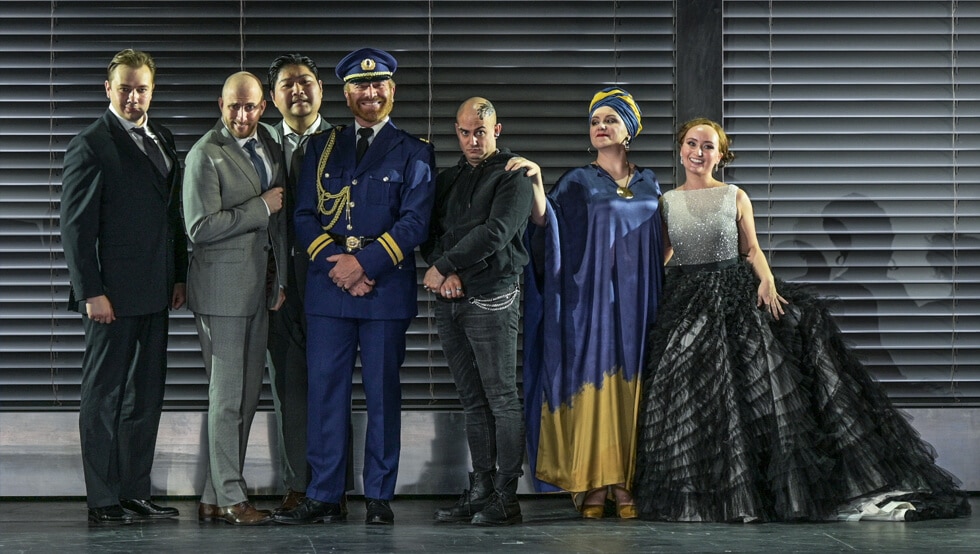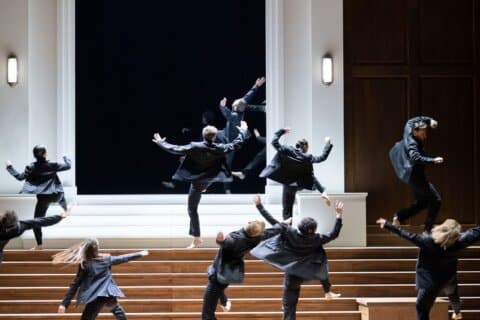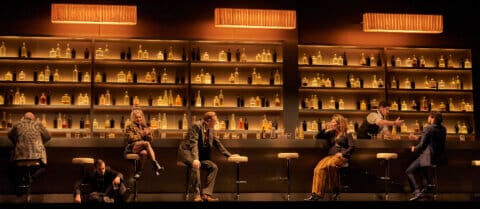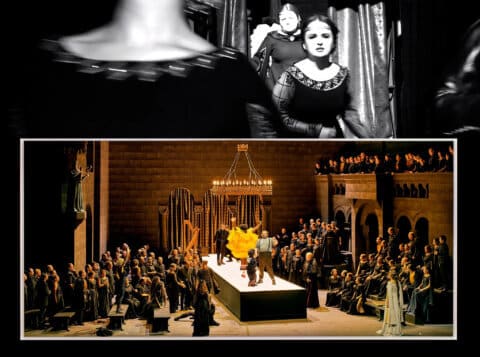AGRIPPINA | HAMBURG STAATSOPER
★★★★★

Image: Hans Jörg Michel
REVIEW: AGRIPPINA: SEX AND BELLY LAUGHS
No one can resuscitate classic opera material quite like Barrie Kosky. He modernises it, makes it infinitely relevant and stunningly entertaining.
Take Handel’s three-and-a-half-hour Baroque opera from 1709. One long drawn-out yawn? Think again! Agrippina is masterful. It is musical sleight of hand with an evergreen satirical libretto laid in the hands of a true magician of the theatre. Worth every penny!
We’re in 2020 and the production has now reached Hamburg. In 2019, I was lucky enough to attend the première at the Munich Opera Festival, long before any of us had even learned to spell COVID-19.
The production was deservedly nominated for the Opera of the Year/New Production award at the International Opera Awards in 2020. Incidentally, the category winner was La Monnaie’s (Brussels) production Rimsky-Korsakov’s fairy tale opera The Tale of Tsar Saltan, a fact of which I might usefully have been aware at the time. Agrippina plays again in December – the perfect excuse to do a bit of Christmas shopping and opera in Hamburg.
Agrippina was known to be the most evil woman in Ancient Rome. The historical truths about her would be ideal for a blood-splattered blockbuster series on Netflix.
A woman who sought to make something of herself, she had a great appetite for powerful men, whom she entwined around her little finger and shamelessly abused in order to achieve power for herself.
In a crafty move, she wedded her uncle, Emperor Claudius, later poisoning him, as she was hell-bent on coming to power via her son Nero (she also screwed around with him from time to time, this was the Roman Empire after all).
Her plan went awry. In the end, having not only survived a mock sailing accident but also foiled multiple attempts to poison her by taking antidote in time, she was stabbed to death by a hired assassin.
Her last words were Stab my belly, a kind of payback to Nero, who had ordered his mother’s killing as he was sick and tired of her meddling in his affairs.
As Roman Emperor, Nero himself was the epitome of callous brutality and unrelenting cruelty. However, an exhibition at the British Museum currently questions whether Nero’s dastardly reputation is fake news based on 2000 years of disinformation. Good Heavens, is there nothing we can trust? Get over there and see for yourself. The exhibition closes on 24 October.
By way of contrast, Barrie Kosky’s awesome production of Handel’s fine Baroque opera Agrippina is a cheerful rendition of the story of a woman who manipulates everything and everyone in pursuit of power.
Kosky has remodelled every intrigue to create a Marx Brothers-like comic opera in a modernistic, minimalist setting wrought in stainless steel.
No mistake, wit shimmers in the burnished metal backdrop. The piece exposes the lust for power and examines the cost of success.
The music in itself is sufficient to secure the production’s success. Eminently delivered under the leadership of Riccardo Minasi, conducting with his violin in one hand and from time to time, playing the instrument masterfully.
Baroque music at its best with dazzling coloratura and beautiful, emotional arias.
The cast of sizzling singers is headed by Soprano Julia Lezhneva in the role of Poppaea. Her energetic performance and canary yellow chiffon robe are the engine that drives the key elements of intrigue.
The plot starts with reports that Agrippina’s husband, Emperor Claudius, has died on the battlefield.
Armed with political flair and vague promises (of a sexual nature, of course), Agrippina gathers strategic support in the senate to appoint her 16-year-old son Nero as emperor so that she can run the show from backstage..
Countertenor Franco Fagioli sings Nero marvellously, studded as he is with piercings, his skull tattooed, resplendent in his punk outfit and Doc Martens – typical Kosky, a clash of era and style.
Nero is more interested in bedding the lovely Poppaea and stupid enough to believe that the attraction is mutual. Alas, Poppaea only has eyes for Otho, one of Claudius’ generals who is also at the fatal arena of war.
The shit then hits the fan… At Nero’s investiture, Claudius turns up, alive and kicking, in the shape of Luca Tittoto, whose deep thundering voice delivers a good old-fashioned baritone ticking-off to all and sundry.
Then there is a grotesquely funny brawl with iron rods (it is not often you get belly laughs in a Baroque opera). Agrippina succeeds in turning the situation on its head and Otho is punished for having planned it all, purportedly in quest of power and the hand of the lovely Poppaea, with whom Claudius himself is also besotted. A veritable can of worms!
Otho is, of course, innocent. He is not interested in power. All he wants is Poppaea and in fact it was he that saved Claudius from drowning. He lies bloody and dishonoured on the stage floor while Poppaea very slowly realises that something fishy is going on…
The sequence of complications seems endless and results in a fantastic, sexy bedroom showdown, in which Poppaea has arranged to meet no less than four men. What an unholy mess! Kosky has successfully developed the roles into characters so that the audience consistently expects more shit and giggles.
It is patently obvious that the singers are having a ball. Their frivolity radiates not only to the orchestra but also to the audience who cheer and clap repeatedly in return.
The cards are on the table. The ending is bitter-sweet. Agrippina takes the trick but victory is a lonely place that may not be as sweet as she expected?
Kosky leaves the question unanswered in this colossal opera experience that you definitely should not miss.
Enjoy your trip to Hamburg!

DON’T MISS THE TABLE
Hamburg now has a Michelin three-star restaurant that offers an impertinent dining table concept, great food and excellent wines at reasonable prices. What’s not to like?
Kevin Fehling is the chef and the brains behind The Table, which makes any trip to Hamburg well worth your while.
The restaurant is installed in an high-ceilinged concrete hall with a razor-sharp interior design..
There is only one table. It is extremely long and snakes its way through the room. The table seats only 20 people, each of whom has plenty of space in which to relax.
Although the waiters are assiduously attentive, there is a superlatively hospitable and indeed informal atmosphere here from the word go. Nevertheless, everyone here appreciates that we are up and running top-drawer here at The Table.
Diners can follow the kitchen staff as they work at large kitchen counters, preparing the deluge of dishes that constitutes The Gate to the World menu. There are 16 small dishes, many of which are little more than amuse-bouches. Everything is created to perfection.
Let me name just a few: Organic foie gras with smoked eel, pineapple and pink peppercorn. Fjord trout Tandoori with mango, mustard seed and clear coconut broth, hazelnut cream with banana-curry ice cream and turmeric root… You get the drift.
The wine menu offers a lovely Spätlese, an astonishingly good Spanish/French Viognier, a sprightly glass of Côte Rôtie red and an Austrian Auslese that, to quote Raymond Chandler, was good enough ‘to make a bishop kick a hole in a stained-glass window’.




